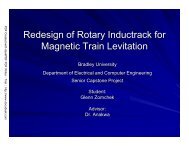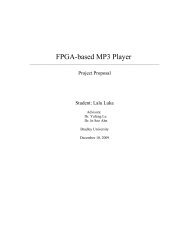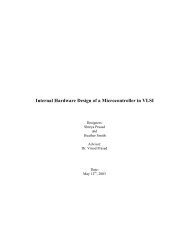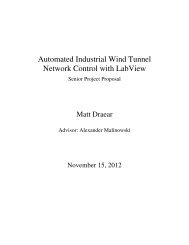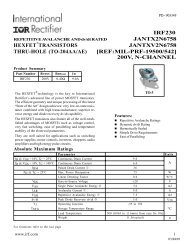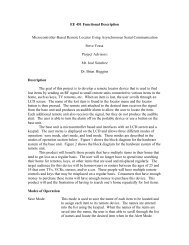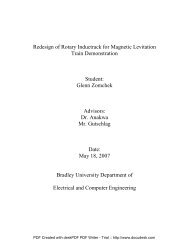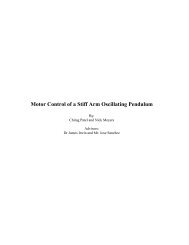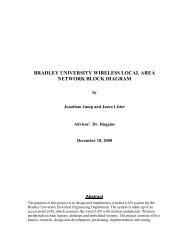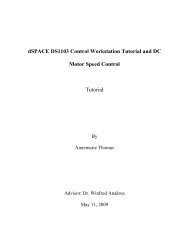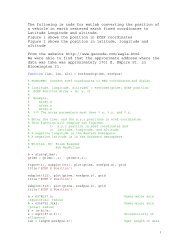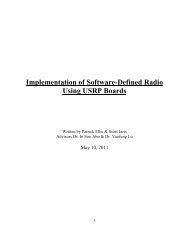Functional requirements and performance specifications. - Bradley ...
Functional requirements and performance specifications. - Bradley ...
Functional requirements and performance specifications. - Bradley ...
You also want an ePaper? Increase the reach of your titles
YUMPU automatically turns print PDFs into web optimized ePapers that Google loves.
Wind Tunnel Control<br />
<strong>Functional</strong> Requirements List <strong>and</strong> Performance Specifications<br />
By:<br />
Adam J. Green<br />
Project Advisor<br />
Dr. Aleks<strong>and</strong>er Malinowski<br />
Date:<br />
November 8, 2010
Introduction<br />
The controller for the wind tunnel system located in the mechanical engineering lab shall<br />
provide students with remote access to both the controls for operation as well as the<br />
measuring of data. This configuration shall simplify control of the wind tunnel as well as<br />
reduce time required to take measurements using the system. Students <strong>and</strong> faculty shall<br />
use a LabVIEW based software application to remotely connect to a PC local to the wind<br />
tunnel system, which shall be connected to the data acquisition device <strong>and</strong> will control<br />
the system.<br />
Goals<br />
During the course of the project, my goals provide incremental steps toward achieving a<br />
complete, network based control/measure system.<br />
- Turn the blower On/Off using LabVIEW.<br />
- Move the wind speed damper Up/Down using LabVIEW.<br />
- Control two actuators using positioning signals from LabVIEW.<br />
- Read measurements from lift/drag/speed sensors in LabVIEW.<br />
- Implement pass-through so that users can use the system remotely.<br />
- Interface local system to remote users via the network.<br />
- Build organized <strong>and</strong> effective GUI for remote application.<br />
High-Level Block Diagram<br />
The block diagram is shown below in Figure-1. The microcontroller will not need to be<br />
reprogrammed or modified after the system is complete, thus will not even need to be<br />
connected to the PC. The data acquisition device shall pass the necessary signals from the<br />
network, through the local PC, to the rest of the system. The measurements shall then be<br />
sent out through the same device to the remote users.
Figure-1: High-Level System Block Diagram<br />
National Instruments Digital <strong>and</strong> Analog Data Acquisition Device:<br />
This is the main I/O component of the system. All of the control <strong>and</strong> measure signals<br />
must be passed through this device in order to be seen in the LabVIEW software <strong>and</strong> thus<br />
seen by the remote users.<br />
8051F120 Microcontroller:<br />
The microcontroller acts as the PWM generator <strong>and</strong> proportional controller for the three<br />
actuators. It is configured to simply read analog inputs to determine the current setting<br />
desired <strong>and</strong> generate PWM pulses for each actuator to position them correctly. The<br />
software block diagram for the code implemented on the microcontroller is shown on the<br />
following page.
Figure-2: Microcontroller Software Block Diagram<br />
Electronic Circuity, Peripherals, <strong>and</strong> Interfacing:<br />
The H-bridges are used step up the PWM signal from the microcontroller <strong>and</strong> provide the<br />
required current to the actuators. The sensors provide the data to be analyzed <strong>and</strong><br />
recorded by the LabVIEW sotware, <strong>and</strong> the interfacing for these sensors includes the<br />
power supply <strong>and</strong> any signal conditioning that must be completed prior to connecting to<br />
the DAQ. The remote interface will need to be developed in the LabVIEW software <strong>and</strong><br />
use the existing network via the PC for remote connectivity.<br />
<strong>Functional</strong> Requirements<br />
The wind tunnel system is a fairly slow <strong>and</strong> predictable system, but it was necessary to<br />
set minimum system <strong>specifications</strong> to focus our design approach. These <strong>requirements</strong> are<br />
show below.<br />
Microcontroller:<br />
1. The microcontroller shall have a minimum of 4 channels of ADC in order to be<br />
used as a controller for the actuators.<br />
2. The frequency of the PWM signal to control the actuators shall be set to 1KHz.
3. The interrupt routine performing the ADC shall execute significantly fast as to not<br />
delay execution of the main controller loop.<br />
4. The positioning value input to the ADC shall have a range of 0.5 to 2.9 volts<br />
when the reference voltage is set to 3.28 volts.<br />
5. The ADC shall have a resolution of 0.0013 volts/division.<br />
6. The ADC shall have a tolerance of +- 10 divisions at the desired position, due to<br />
line noise, <strong>and</strong> differences in actuator voltages <strong>and</strong> potentiometers.<br />
H-bridge Circuitry:<br />
1. The H-bridge circuitry shall carry a maximum in-rush current of 3 amps to the H-<br />
bridges <strong>and</strong> actuators.<br />
2. The H-bridge circuitry components shall be capable of dissipating power with 3<br />
amps of current through the circuit (about 36 watts for less than 1 millisecond, 2<br />
watts nominal).<br />
Electronic Circuitry/Interfacing:<br />
1. The interfacing between the LabVIEW control <strong>and</strong> wind tunnel system shall<br />
completely isolate the DAQ, microcontroller, <strong>and</strong> PC from the wind tunnel<br />
system using solid state relays.<br />
2. The interfacing component <strong>specifications</strong> shall match the voltage <strong>and</strong> current<br />
<strong>specifications</strong> of the DAQ <strong>and</strong> microcontroller.<br />
Digital <strong>and</strong> Analog Data Acquisition Device:<br />
1. The DAQ shall have a minimum of 3 analog inputs <strong>and</strong> 2 analog outputs used to<br />
control the actuators <strong>and</strong> read in lift, drag, <strong>and</strong> wind speed measurements.<br />
2. The DAQ shall have a minimum of 5 digital I/O used to control the components<br />
of the wind tunnel <strong>and</strong> trigger movement of the actuators.<br />
3. The DAQ shall be a PCI MIO-16E-4 by National Instruments provided by the<br />
Mechanical Engineering Department at <strong>Bradley</strong> University.
Computer <strong>and</strong> LabVIEW Software:<br />
1. The PC shall be equipped with Windows XP <strong>and</strong> the most recent version of<br />
LabVIEW available at the time of assembly. This machine shall be specified <strong>and</strong><br />
provided by the Mechanical Engineering Department at <strong>Bradley</strong> University at a<br />
later date.<br />
2. The LabVIEW application shall format any gathered data into a user-definable<br />
file after a data acquisition session is complete.<br />
3. The LabVIEW application shall contain the following end-user I/O:<br />
Conclusion<br />
a. System on/off. (input)<br />
b. Positioning settings for two actuators (height <strong>and</strong> pitch). (input)<br />
c. Wind-speed damper open. (input)<br />
d. Wind-speed damper close. (input)<br />
e. Wind-speed sensor reading. (output)<br />
f. Lift sensor reading. (output)<br />
g. Drag sensor reading. (output)<br />
While the overall goal is to implement a complete, remote package to control the wind<br />
tunnel system, a systematic approach will be the most beneficial. By working through<br />
each step, the system will become more complete while remaining in a useable state<br />
throughout the process. This is important so ME students can continue to use the wind<br />
tunnel throughout the course of the project.<br />
References<br />
[1] Ben Morrison, “Senior Project - Webwind”, Senior Project, Electrical <strong>and</strong> Computer<br />
Engineering Department, <strong>Bradley</strong> University, March 2002.<br />
[2] Silicon Laboratories, C8051F12x Development Kit User’s Guide.<br />
[3] Silicon Laboratories, C8051F120 Datasheet<br />
[4] National Instruments, PCI-6229 Datasheet<br />
[4] Omron, G3NA-225B Datasheet



